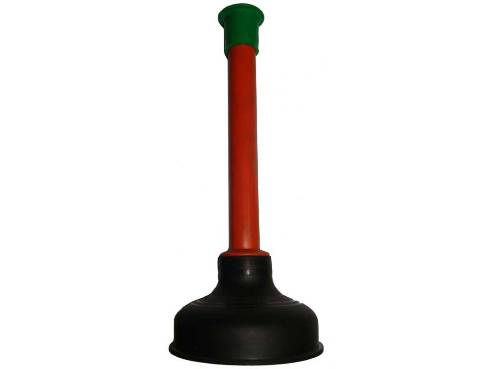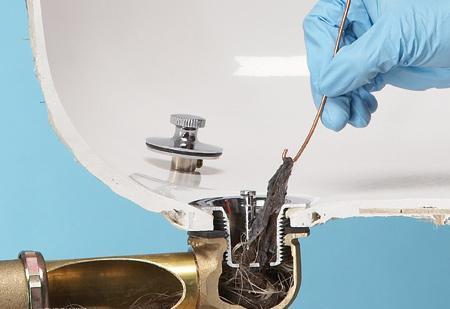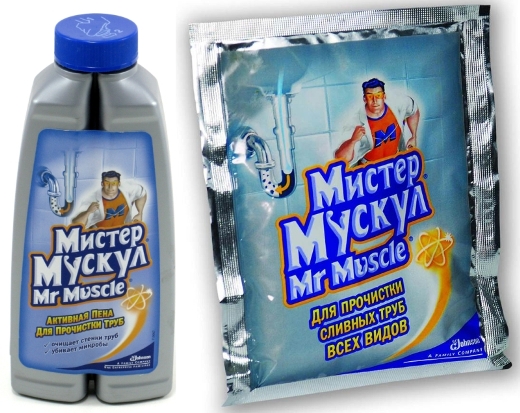It happens that after taking a water procedure, the water flows very slowly into the sewer. This should immediately alert, since such a phenomenon indicates that a blockage has formed in the bath - what to do in this case?
This trouble can be eliminated in several ways - mechanical, thermal or chemical.
The bathtub is clogged. What to do?
The mechanical method of cleansing includes:
- The use of a plunger.
- Cleaning the siphon.
- Using a plumbing cable.
- Water hammer.
The thermal method of clearing the blockage involves the use of hot water. For sure, everyone is familiar with chemicals from wide advertising in the media. Which way to choose? It all depends on the type of blockage and its location.
There are many reasons for this. If it comes to an individual dwelling, then it may be the wrongly chosen slope of the sewer pipe. Since the movement of wastewater occurs naturally, the pipe through which household waste flows down must be laid at a certain slope.
An improperly laid pipe will accumulate various small waste, human hair and pet hair, fats, and lime deposits contained in the water will form. At the same time, the lumen of the pipe narrows, and over time a plug will form, which will become an obstacle to the passage of sewage.
|
|
It must be said that deposits most often occur in cast iron pipes, due to their rough inner surface.
However, most often the blockage of the pipe in the bathroom is formed due to not observing the simple rules for the operation of plumbing fixtures.
It should only be:
- Carry out regular cleaning of drains with a household plunger.
- Use fine mesh drainage grates that must be cleaned after each use of the bath.
- Use household chemicals for prophylaxis.
- Check the access doors periodically and clean the siphon under the bathtub.
Mechanical clogging control methods
First of all, it is necessary to establish in what place the traffic jam has formed:
- If the water does not just leave the bath , then the reason is most likely a clogged pipe that connects this plumbing fixture to a common sewer line.
- If the water does not drain well or does not drain at all from all points of water parsing , then here most likely there was a clogging of the common sewer riser, and you can hardly do it on your own.
You will have to call the plumber on duty for help or contact an organization that provides assistance in such situations.
Let us first figure out how to remove the blockage in the bathroom on our own.
If the water does not leave only from the bath, then first of all you need to use a plunger, and if the use of this tool does not help, proceed to cleaning the siphon.
We use a plunger
This tool, which must be in every apartment with a sewer network, is a hemisphere of soft rubber, which is firmly attached to a wooden handle.

The plunger is a simple and reliable "cleaning device"!
We press this device tightly against the drain hole of the bath, having previously closed the upper overflow hole hermetically and filled the container with water. After that, you should make several vigorous swinging "up and down" with the handle. In this case, water under a powerful pressure will break up the debris accumulated in the pipe, and push it further to the central riser.
And when all the water goes into the drain, the last pumping with a plunger removes the remaining debris to the surface of the bottom of the bath, which must be removed manually. Water usually starts to drain out of the bathtub quite normally. This can be seen from the formed funnel above the drain. For a guarantee, the procedure can be repeated. If it is not possible to hermetically close the bath overflow, you can use a second plunger for this, but here you cannot do without the help of a second person.
We check the cleanliness of the siphon
If the work with the plunger has not brought tangible results, in order to clear the blockage in the bathroom, it is necessary to check the condition of the siphon. This work, of course, is a little more difficult than using a plunger. But easier than using a plumbing cable. In addition to cleaning the inside of the siphon from debris, during this procedure, an unpleasant odor is removed, which is always present in such places.

Drain clogs hair and coat
It must be remembered that there is always a certain amount of water in the siphon, which serves as a water seal. Therefore, in order not to get dirty yourself and not to spoil the floor covering, it is necessary to substitute some kind of container or put a rag. After that, the bottom cover of the siphon is removed, which in modern plumbing fixtures is usually fastened with a threaded nut.
The inside of the siphon must be thoroughly cleaned of debris and rinsed with hot water, removing fat and other deposits. Then reassemble the siphon in reverse order and check its tightness by filling the bath with water.
Such procedures are recommended to be carried out not only when there is a poor outflow of water, but also for preventive purposes once a quarter, even with normal operation of the drain hole, so that there is no such issue as removing blockages in the bath.
Radical and efficient plumbing rope
If a small local blockage can be removed with the help of a plunger, then a plumbing cable will help to cope with larger troubles in the sewage system, when the blockage is much further than the siphon.

Removing a blockage in the bathroom with a plumbing cable
This tool is a flexible, spiral-shaped metal cable. A variety of end caps can be used to help break the most stubborn blockages quickly. On the other side there is a handle, with which the cable is more easily pushed into the sewer pipe.
You can remove a strong blockage in the bath using a cable if you follow the following operating procedure:
- The end of the cable with a nozzle is inserted after removing the siphon into an open sewer pipe.
- The cable should be moved forward, constantly rotating it along its axis. It is easier to carry out this type of work with a partner, when one pushes the cable, and the second at this time rotates it, but in one direction.
- When the cable rests against the blockage itself, it is necessary to make several "back and forth" movements. In this way, it is possible to break through the blockage in the bathroom, as evidenced by the weakening of the cable tension.
- The last stage of work is to pull the cable out of the pipe and flush it.
- To finally make sure that the blockage is defeated, you need to pour water into the pipe and observe how fast it will go. If the result is not satisfactory, the operation must be repeated.
Plumbing cables are manual and electric. In the latter, rotation is carried out using a motor.
It is important to remember that it is possible to remove a strong blockage in the bath using a plumbing cable if the sewer pipe is not made of plastic or chrome-plated metal, in order to avoid damage to their inner surface.
After completing any kind of mechanical cleaning, the sewer pipe should be rinsed with plenty of hot water to remove the remaining blockage and fat deposits.
Household and chemical blockage control methods
If water is draining from the tub, but slowly, simple methods of removing blockages should be tried first. The simplest remedy for a blockage in a bathroom is simple baking soda and boiling water. Pour baking soda into the drain and pour the vinegar into the drain. A chemical reaction occurs, as a result of which the pipe will be cleared of fat and other layers. Soda, when it comes into contact with vinegar, causes strong foaming, therefore it is recommended to close the hole with a stopper.
Hot water can dissolve fatty deposits, but that's all.
More effective means are such well-known drugs:

Before using any chemical product, you must carefully study the instructions for its use.
If there is no way to fix it yourself?
It is not always possible to clear the blockage of the bath on your own. And in this case, the appropriate services can come to the rescue, which in a matter of minutes will easily deal with a blockage of any complexity.
For cleaning the sewage system in an apartment, country house, office or at an enterprise, employees of a similar organization can use:
- Manual cleaning, the cost of which in Moscow can be up to 2500 rubles.
- Sewerage cleaning with equipment based on pneumatic pulses, the price will be up to 4000 rubles.
- The Rothenberder sewer spiral machine, the call of which will cost 7,000 rubles, is used for electromechanical cleaning.
- The hydrodynamic method of clearing blockages is carried out using a Renault machine. The price of such a service will cost 8,000 rubles.
- In case of large blockages that cannot be destroyed by all of the above means, a Scania machine can be used, which creates a pressure of up to 600 atm, which allows you to remove blockages from pipes with a diameter of up to 800 mm.
In addition to helping in getting rid of blockages, the organization can make video diagnostics of those places of the sewage system where problems with old worn-out pipes are possible for their cracks, displacement, as well as the quality of the cleaning performed.
And in conclusion, I would like to say that preventing a blockage is easier than eliminating its consequences.
